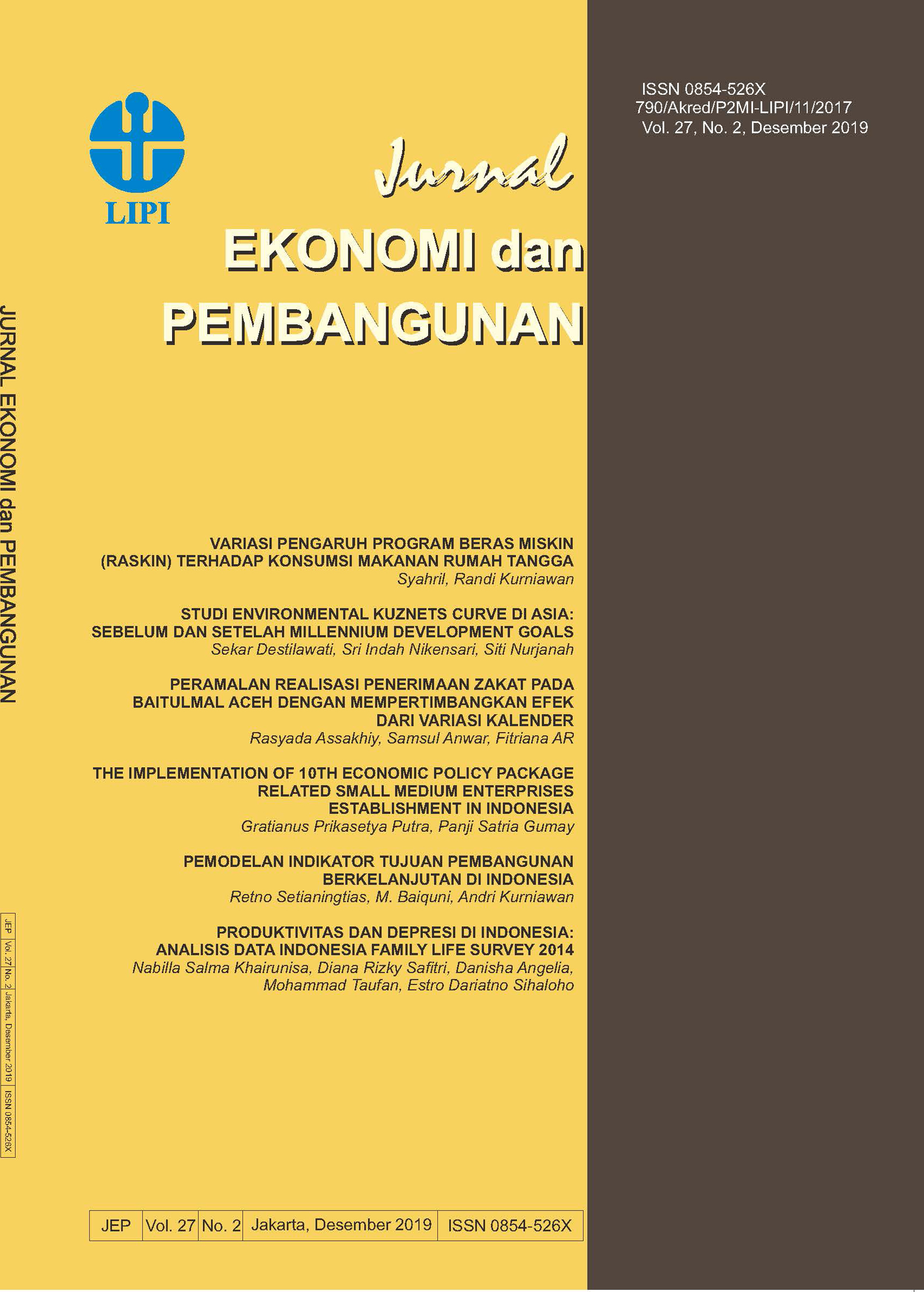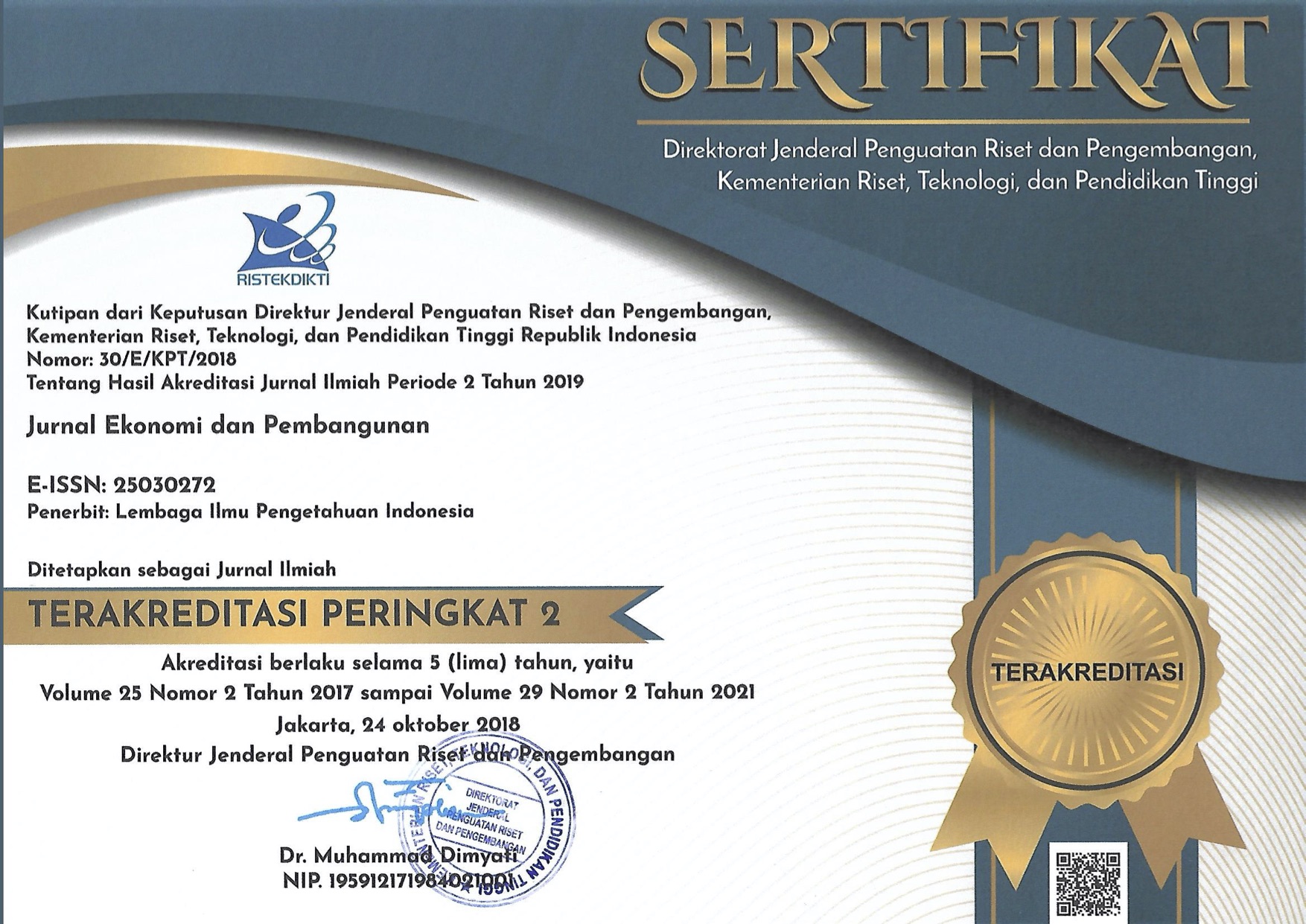PEMODELAN INDIKATOR TUJUAN PEMBANGUNAN BERKELANJUTAN DI INDONESIA
Abstract
Arah baru dalam proses pembangunan saat ini adalah pelaksanaan Sustainable Development Goals (SDG)/ Tujuan Pembangunan Berkelanjutan (TPB). Konsep pembangunan berkelanjutan disusun atas empat dimensi, yaitu pembangunan ekonomi, sosial, lingkungan dan kelembagaan. TPB hadir dengan 17 tujuan dan sejumlah indikator untuk pengukurannya. Penelitian ini bertujuan untuk menganalisis hubungan antar indikator dan dimensi dalam pembangunan berkelanjutan. Identifikasi indikator berasal dari publikasi Bappenas dan BPS, serta hasil penelitian terdahulu. Unit analisis pada penelitian ini adalah seluruh provinsi yang ada di Indonesia dengan menggunakan data tahun 2015. Metode yang digunakan adalah Struktural Equation Modelling menggunaan Partial Least Square untuk mereduksi indikator serta melihat hubungan antar dimensi sosial, ekonomi, lingkungan dan kelembagaan. Hasil seleksi indikator menunjukkan dari lima puluh indikator, menjadi sembilan belas indikator yang berpengaruh terhadap pembangunan berkelanjutan. Permodelan dengan SEM PLS memberikan gambaran bahwa antar dimensi ekonomi – lingkungan, ekonomi –sosial, kelembagaan –ekonomi, ekonomi – kelembagaan, kelembagaan – sosial, kelmbagaan – TPB, Lingkungan – TPB, sosial – lingkungan, sosial - TPB dan TPB – kualitas pembangunan menunukkan hasil yang signifikan, namun demikian terdapat hubungan yang tidak signifikan, yaitu hubungan antara antara kelembagaan dan lingkungan.
Downloads
References
Abel, G. J., Barakat, B., Kc, S., & Lutz, W. (2016). Meeting the Sustainable Development Goals leads to lower world population growth. Proceedings of the National Academy of Sciences of the United States of America, 113(50), 14294–14299. https://doi.org/10.1073/pnas.1611386113
Alders, P., & Broer, D. P. (2005). Ageing, fertility, and growth. Journal of Public Economics, 89(5–6), 1075–1095. https://doi.org/10.1016/J.JPUBECO.2004.06.001
Alisjahbana, Armida Salsiah;, Yusuf, A. A., Anna, Z., Kadarisman, A., Maulana, N., Larasati, W., … Megananda; (2018). Menyongsong SDGs Kesiapan Daerah-daerah di Indonesia (2nd ed.). Bandung: Unpad Press.
Alisjahbana, Armida Salsiah, & Murniningtyas, E. (2018). Tujuan pembangunan berkelanjutan di Indonesia : konsep, target dan strategi implementasi (2nd ed.). Bandung: Unpad Press. Retrieved from http://sdgcenter.unpad.ac.id/sdgs-books/tujuan-pembangunan-berkelanjutan-di-indonesia-konsep-target-dan-strategi-impelemtasi/
Bakril, B. (2017). Pengembangan Indikator, Tipologi, Dan Status Pembangunan Berkelanjutan Daerah Provinsi di Indonesia. Institut Pertanian Bogor.
Carmela, M., Bue, L., & Klasen, S. (2013). Identifying Synergies and Complementarities Between MDGs : Results from Cluster Analysis, 647–670. https://doi.org/10.1007/s11205-013-0294-y
Castañeda, G., Chávez-Juárez, F., & Guerrero, O. A. (2018). How do governments determine policy priorities? Studying development strategies through spillover networks. Journal of Economic Behavior & Organization, 154, 335–361. https://doi.org/10.1016/J.JEBO.2018.07.017
Davies, R. (2015). The sustainable development goals as a network of targets. Monitoring and Evaluation NEWS. Department of Economic and Social Affairs, 1(141), 1–17. Retrieved from http://www.un.org/esa/desa/papers/2015/wp141_2015.pdf
Fauzi, A., & Oxtavianus, A. (2014). The Measurement of Sustainable Development in Indonesia. Jurnal Ekonomi Pembangunan, 15(1), 68–83.
Ghozali, I., & Latan, H. (2015). Partial Least Square Konsep, Teknik, Dan Aplikasi menggunakan Progam SmartPLS 3.0 (Edisi 2). Semarang: Badan Penerbit UNDIP Semarang.
Hair, J. F., Black, W. C., Babin, B. J., & Anderson, R. E. (2014). Pearson New International Edition: Multivariat Data Analysis. Exploratory Data Analysis in Business and Economics. https://doi.org/10.1007/978-3-319-01517-0_3
Kelley, A. C., & Schmidt, R. M. (1999). Economic and Demographic Change: A Synthesis of Models, Findings, and Perspectives. SSRN. https://doi.org/10.2139/ssrn.152888
Le Blanc, D. (2015). Towards Integration at Last? The Sustainable Development Goals as a Network of Targets. Sustainable Development, 23(3), 176–187. https://doi.org/10.1002/sd.1582
Nilsson, M. (2016). Understanding and mapping important interactions among SDGs: Readying institutions and policies for integrated approaches to implementation of the 2030 Agenda. In Expert meeting in preparation for HLPF 2017 (pp. 1–33). Retrieved from https://sustainabledevelopment.un.org/content/documents/12067Understanding and mapping important interactions among SDGs.pdf
Nilsson, M., Griggs, D., & Visback, M. (2016). Map the interactions between Sustainable Development Goa. Nature, 534(15), 320–322. https://doi.org/10.1038/534320a
Otok, B. W. (2013). Pemodelan Kemiskinan Di Jawa Timur Dengan. Statistika, 1(2).
Oxtavianus, A. (2014). Pembangunan berkelanjutan dan hubungannya dengan modal sosial di indonesia. Institut Pertanian Bogor.
Pradhan, P., Costa, L., Rybski, D., Lucht, W., & Kropp, J. P. (2017). A Systematic Study of Sustainable Development Goal ( SDG ) Interactions Earth ’ s Future. Earth’s Future, 1169–1179. https://doi.org/10.1002/eft2.266
Weil, D. N. (2006, April 1). Population Aging. Retrieved from https://papers.ssrn.com/sol3/papers.cfm?abstract_id=896219
Copyright (c) 2019 Jurnal Ekonomi dan Pembangunan

This work is licensed under a Creative Commons Attribution-NonCommercial-ShareAlike 4.0 International License.
Terms and Conditions of Publication
1. Author's Rights and Authorities
As an author, you (or your employer or institution) may do the following:
-
make copies (print or electronic) of the article for your own personal use (not for commercial purpose), including for your own classroom teaching use;
-
make copies and distribute such copies (including through email) of the article to research colleagues, but not allowed to distribute commercially and systematically, e.g. via an email list or list server;
-
present the article at a meeting or conference and to distribute copies of the article to the delegates attending such meeting;
-
retain all proprietary rights in any process, procedure, or article of manufacture described in the work;
-
include the article in full or in part in a thesis or dissertation;
-
use the article or any part thereof in a printed compilation of your works, such as collected writings or lecture notes, and other derivative works, with full acknowledgement to JEP as the original journal publishing the article;
-
may reproduce material extracted from the article or derivative works for the author's personal use, but must consider the copyrights procedure.
All copies, print or electronic, or other use of the paper or article must include the appropriate bibliographic citation for the article’s publication in the journal.
2. Requests from Third Parties
Although authors are permitted to re-use all or portions of the article in other works, this does not include granting third-party requests for reprinting, republishing, or other types of re-use. Requests for all uses not included above, including the authorization of third parties to reproduce or otherwise use all or part of the article (including figures and tables), should be referred to P2E-LIPI by going to our website at http://ekonomi.lipi.go.id/.
3. P2E LIPI Copyright Ownership
Economic Research Center, the Indonesian Institute of Sciences (P2E-LIPI) owns the copyrights to reproduce, distribute, disseminate, translate, and other uses in accordance with the existing Laws and Regulations.
Every accepted manuscript should be accompanied by "Copyright Transfer Agreement" prior to the article publication.

This work is licensed under a Creative Commons Attribution-NonCommercial 4.0 International License.
JEP Journal by P2E-LIPI is licensed under a Creative Commons Attribution-NonCommercial-ShareAlike 4.0 International License. Permissions beyond the scope of this license may be available at http://jurnalekonomi.lipi.go.id/index.php/JEP
If you are a nonprofit or charitable organization, your use of an NC-licensed work could still run afoul of the NC restriction, and if you are a for-profit entity, your use of an NC-licensed work does not necessarily mean you have violated the term.






